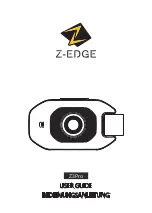
M08627;11/39
- 11 -
(Note) Carefully note that the temperature data obtained by this monitoring function is not for the ambient temperature but
the internal temperature of the camera. As a general rule, the internal temperature of the camera is higher than the
ambient temperature because of the heat generation associated with the consumed electric power inside the
camera.
Even when the temperature monitored by this function exceeds the value of the “Operation ambient temperature”
shown in the specifications of the camera, no operational trouble will be caused as long as the ambient
temperature is equal to the one of the specifications or lower, and sufficient countermeasures against temperature
are taken.
●
Detection performance for temperature data
Temperature resolution :
0.5°
Update interval of data :
0.4 sec.
Temperature detection accuracy:
±2°C (-40°C to +85° C), +3 to -2°C (55°C to 125°C)
Effective data range :
-55°C to 125°C (as long as t he operation ambient temperature of the camera is
within the range defined by the specifications.)
●
Temperature data by RS-232C communication
The temperature data to be returned in response to the “RTMP” command of RS-232C is generated in the following
format:
[Data format]
The lower 10 bits out of the 16 bits of the returned data are valid.
XXXXXD9D8…D0 (invalid upper 6 bits/valid lower 10 bits as the data)
Db=B’D9D8…D0 in the binary system shows a signed integer value in two’s complement form.
However, the effective range of the temperature data is limited to the following due to the operational restriction of the
temperature sensor:
Effective range of temperature data: -110 (-55°C) to +250 (125°C)
(Note) The accuracy of the values of the temperature data is not guaranteed when the operation ambient temperature is
not within the range defined by the specifications.
[Conversion method from retuned data to temperature in Celsius]
The temperature in Celsius is computed as Tc from the following formula where Dt is the signed integer number converted
from the above described 10 bit binary value of “Db=B’D9D8…D0”:
Internal temperature of camera: Tc=Dt×0.5°C
(Example 1) Where Td, the returned value of the temperature data, is “H’0032” in the hexadecimal system, it is
expressed in the binary system as follows:
Td=H’0032=B’0000.0000.0011.0010
∴
Db=B’00.0011.0010 =+50 (Only upper 10 digits of Td are valid.)
Then, Tc is calculated from the following formula: Tc=+50×0.5°C=+25°C
(Example 2) Where Td, the returned value of the temperature data, is “H’03FA” in the hexadecimal system, it is
expressed in the binary system as follows:
Td=H’03F1=B’0000.0011.1111.1010
∴
Db=B’11.1111.1010 (Only upper 10 digits of Td are valid.)
→
Dt=-6 (
↓
Refer to [Explanation])
Then, Tc is calculated from the following formula: Tc=Dt×0.5°C=-6×0.5°C=-3°C
[Explanation] Example of conversion algorithm from data in the complement number system to signed data
The following example shows how to convert 10 digit data in the complement number system into ordinary signed data:
(1) Whether the value is positive or negative is determined by checking the uppermost bit (MSB) out of the 10 digit
number. When the MSB is 0, “+” is added, and when it is “1”, “-“ is added to the number (absolute value) to be obtained
in accordance with the below described (2).
(2) The absolute value is obtained from a binary number expressed in the remaining 9 digits including the lowermost bit
(LSB) as follows:
Simply convert into an integer number if the MSB is 0 (”+” sign) in accordance with (1).
Reverse each of all the 9 digits and add 1 to the result if the MSB is 1 (“-“ sign) in accordance with (1).
(3) The signed number is obtained from (1) for the sign and (2) for the absolute value.
* In the case of the (Example 2) as above, its sign is “-“ because the MSB is 1 in accordance with (1). The absolute value
is “6” because of (invert(B'11 1 = B'001 = 5+1 =6) in accordance with (2). Therefore, this value (Dt) is
expressed as “-6” in the ordinary signed number system.












































